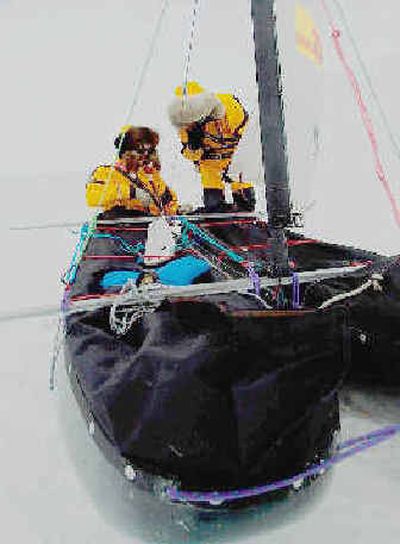Coming or going? It was hard to tell

ANCHORAGE, Alaska — A helicopter airlifted two adventurers from drifting sea ice in the Bering Strait, ending their attempt to be the first to cross the strait to Siberia and back.
Belgian Dixie Dansercoer, 42, and Alaskan Troy Henkels, 38 were picked up Wednesday on firm but swiftly moving pack ice, 55 miles south of Wales, Alaska, before 30 mph winds grew stronger.
Fifty-six miles marks the shortest distance between shores on the narrow but erratic channel. The men had skied about that distance but wound up nowhere near the Siberian shore.
“It’s a wild place,” Henkels said Thursday from basecamp in Nome.
For more than two decades the strait has lured adventurers to cross it by various means including bike, car, tank, dogsled, kayak and balloon. Most fail or chicken out. Several have been rescued. Only Russian Dmitry Shparo and his son Matvey have made it into the Guinness Book of World Records for crossing the strait on foot in 1998, after their third attempt.
Dansercoer and Henkels wanted to one up the Russians and cross it in both directions.
With $250,000 in sponsorships and the patronage of Belgium’s Crown Prince Philippe, they set out on March 30 from Wales, the farthest point west on the North American continent. They headed toward Siberia, beginning the trek by sailing in their buoyant sleds. But from the onset the current spit the men out of the icy passage and sent them south.
For eight days, Dansercoer and Henkels were skiing across moving ice floes, trying to travel west, but a southern current sent their ice deeper into the open Bering Sea. At one point, the men tried to fight the drift by skiing east only to discover their own ski tracks miles later.
Each day the men had to find a path through jumbled blocks of ice, often retreating from impassable deadends. Slushy ice and gaps of open water routinely confronted them as they drifted uncontrollably off course, each hauling 265 pounds on their sleds.
“We tried every day,” Henkels said. “We traveled for eight hours and might get six miles. We’d camp for 10 or 12 hours and lose 12 miles.”
Henkels said the two have not yet decided whether they will try the strait again.